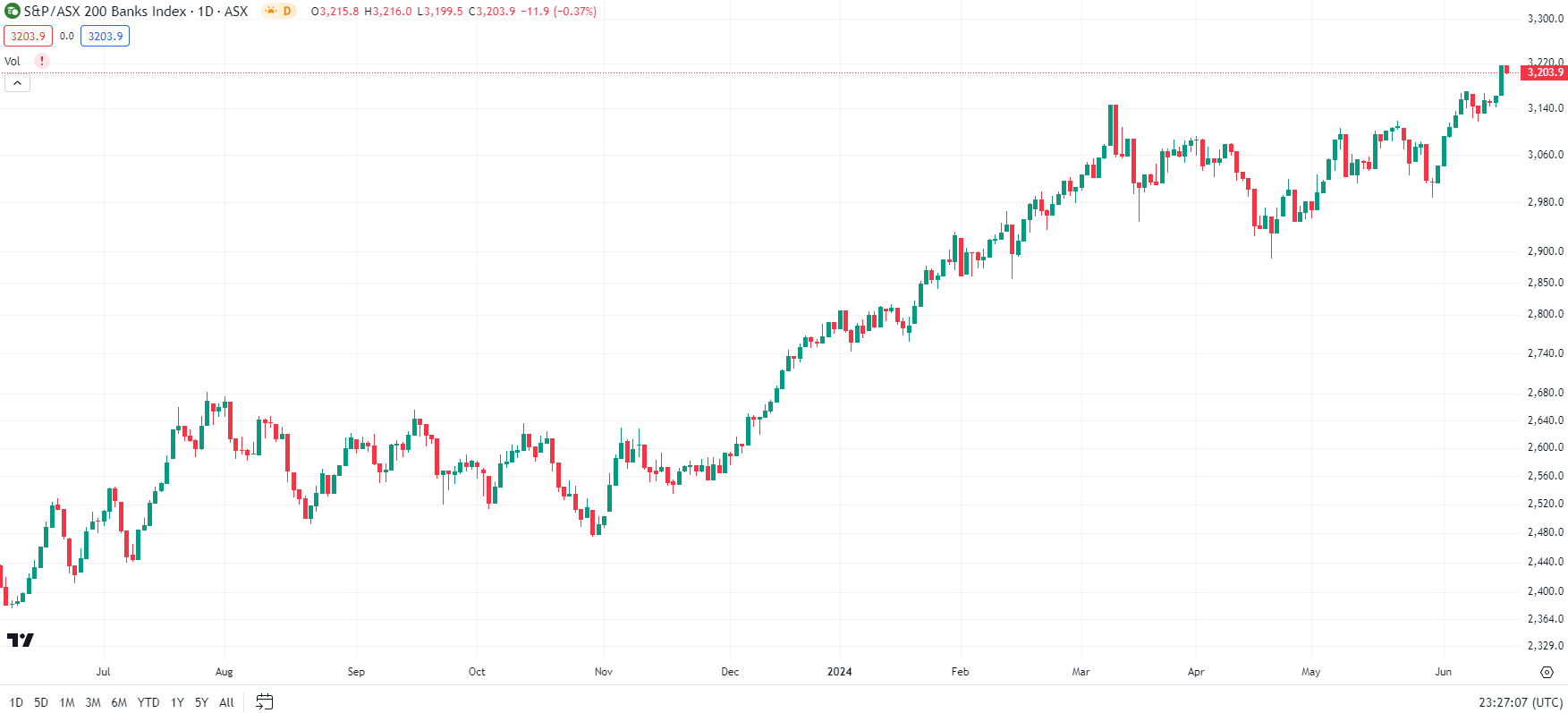Some say the Big 4 Banks are Too Expensive, but are they really?
![]() Ujjwal Maheshwari, June 25, 2024
Ujjwal Maheshwari, June 25, 2024
‘The Big Four Banks are Too Expensive’, it is often asserted, both by retail investors and professional analysts alike. Australia’s So–called Big 4 banks — Commonwealth Bank (CBA), Westpac, National Australia Bank (NAB), and Australia and New Zealand Banking (ANZ) —have long been the stalwarts of the nation’s financial system. With a combined marketcap of roughly half a trillion dollars as of mid-June 2024, these banks dominate the Australian financial industry and many metrics of the ASX including proportion of the top 200’s total market capitalisation, highest dividends paid and highest buybacks made (they made more than half).
However, some believe they may have become too expensive for their own good. Morningstar, Citi, Lazard, Macquarie and Jarden are just some of the institutions that have at least told investors to exercise caution. Yet, the ASX 200 Banking Index keeps going up – having gained nearly 30% since late October 2023, more than double the rest of the ASX 200. Heck, it has even gained 9% since mid-April when Citi (the most bearish of the aforementioned institutions) recommended to sell them all. What’s the story?

ASX 200 Banking Index, log scale (Source: TradingView)
Why the Big four are admired
There are many reasons why Big 4 banks are big. Most notably because they are big – all starting starting as local entities before growing through acquisitions and mergers. Their M&A activity was just retail banking operations, but even purchasing other financial companies such as mortgage brokerages and even consumer focused fintechs. The Commonwealth Bank for instance, bought Aussie Home Loans and then Lendi.
Deregulation of the banking sector increased the Big 4’s market share from around 50% in the early 1980s to about 80% today. This concentration is much higher than in many other developed countries, where the top five banks often hold less than 50% market share. This in its own right has made it more difficult for smaller, regional banks unwilling to bite the bullet to compete. There are other structural market advantages too. Unlike US banks, which deal with long-term fixed-rate loans and bond market exposure, Australian banks primarily issue floating-rate loans.
Another significant factor contributing to the Big 4’s dominance is their focus on mortgage lending. Mortgages account for over 60% of all bank lending in Australia, compared to 20%-35% in markets like the US, UK, and Germany. This high exposure to real estate has made Australian banks more profitable but also more vulnerable to fluctuations in the housing market.
Australia’s Big 4 banks have also proven popular with investors because they consistently delivered strong profits and generous dividends. In the fiscal year 2023, they reported a record combined profit of nearly $32.5 billion, a 12.4% improvement over the previous year. Commonwealth Bank led the pack with $10.2 billion, followed by NAB at $7.7 billion, ANZ at $7.4 billion, and Westpac at $7.2 billion.
Not all of this was paid out as dividends, but a fair proportion of this was. Just looking at CBA, 12 million super fund members received a combined $2.4bn in earnings. And that does not even account for Australians who hold shares in their own right, outside their super fund. Those people received an average dividend of $3532.
Why some say the Big Four Banks are Too Expensive?
So shouldn’t you buy shares in the banks for all those reason above? Aren’t those reasons why the banks have kept performing despite the bearish sentiments? Can you really keep believing all the doomsayers?

Created by Imgflip
Arguably so, but keep in mind all of these are backwards looking. Bears on the banks are not so optimistic the future will be as rosy.
During the COVID-19 pandemic, Western central banks, including Australia’s, implemented aggressive quantitative easing measures including low interest rates, leading to a surge in deposits and lending. Even though interest rates have risen 12 times, and remained at the current level for months without any major signs that the market will recede, it has come at a cost. The term ‘mortgage wars‘, was no accident. Banks have had to offer cash-back offers and a lower rate to keep those customers – ditto any bank that manages to win across new customers. Have you wondered why ANZ persisted for 2 years to buy Suncorp’s operations (and won) rather than give up? Because it wanted to gain a foothold in the competitive environment.
And we haven’t even mentioned what the mortgage broking industry does to the banks’ margins, namely eat into them. In the search for a good deal, mortgage customers hire brokers to look for the best deal for themselves (at least in theory), and the brokers have to get paid upfront and trailing commissions if they refer a customer. The obvious solution for banks may appear to be to just reject would-be mortgage customers if they use brokers, although that would eliminate over two-thirds of the potential market for them.
Finally, there’s concern about what will happen if and when interest rates fall. Will there be another round of mortgage wars – people seeking to refinance. And also, how far and low will rates go? Not to zero again, of course, but no doubt there’ll be some impact to the banks’ margins.
Decreasing Mortgage Underwriting Standards
The quality of mortgages originated post-COVID-19 is another area of concern. Approximately 20% of these loans were made to borrowers with debt-to-income ratios around six times their income, and 35% had loan-to-value ratios exceeding 80%. If house prices fall by an estimated 10% to 15% to restore affordability, many of these loans could slip into negative equity, posing a systemic risk to the banking system.
Investor Concerns on Ratios
Despite navigating these challenges so far, Australian bank valuations remain high. Adjusted for excess capital, Australian banks trade at a significant premium compared to their European counterparts. For example, Commonwealth Bank trades at 22 times its 2023-24 earnings, while European banks average around seven times.
This high valuation is a double-edged sword. On one hand, it reflects confidence in the banks’ profitability and stability. On the other hand, it makes them vulnerable to any need to bolster capital positions or increase loan loss provisions as delinquencies rise. Such actions could threaten shareholder returns, particularly for those seeking yield.
But for analysts wanting to pinpoint some sector to sell in a bullish market, the banks are an easy target. It is easier to be mocked for recommending a buy on a stock that turned out to be a dud than to recommend a sell on a stock that turns out to be good (except in extreme circumstances when a company that turned out to be a spectacular investment like Amazon turned out to be good). Ultimately, investors should make their own decisions.
What Could happen ahead?
Australia’s Big 4 banks have long been pillars of the financial system, delivering strong profits and dividends. However, their high valuations, significant exposure to the housing market, and potential regulatory and economic challenges suggest they may have become too expensive for their own good.
The dominance of the Big 4 has made it difficult for smaller banks to compete, further consolidating their position. However, this concentration also means that any significant downturn in the housing market or changes in regulatory standards could have widespread implications.
The keys for the banks’ future growth are:
- Maintaining their dominant positions in the mortgage market,
- The Australian housing market continuing to grow (both in demand and supply), and
- Maintaining Interest Margins.
If they can, maybe they will keep growing.
What are the Best ASX Stocks to invest in right now?
Check our buy/sell tips
Blog Categories
Get Our Top 5 ASX Stocks for FY25
Recent Posts
Cettire shares are down over 90% from their all time high as investors follow the leader in selling shares
It hasn’t been a good 14 months for Cettire shares. For a long time after the pandemic, eCommerce was one…
How will stocks be impacted by tariffs? Here are 6 victims on the ASX and how they’re responding
How will stocks be impacted by tariffs? Its a long story, but few stocks can say that there’ll be no…
The $3m super tax is coming! If you’re invested in equities, here is how it might impact you
It seems during the next 3 years, the $3m super tax will be officially a thing. Itwas blocked by the…



